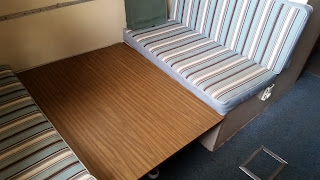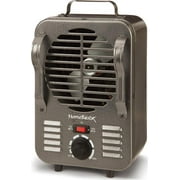The nice thing about these fan heaters is that one can direct the warmth where required without having to heat up a large area. It's also nice to be able to 'hold your hands over the fire' when those fingers get cold or if you want to blow warm air at your tootsies. This isn't easily accomplished with ceramic or oil heaters. BTW - no matter which electric heater you decide on, resistance will be the way it generates heat. Also, a 1500 watt unit for $25 puts out the same amount of heat as a $150, 1500 watt Amish version
These Milkhouse heaters have tip over circuits so they stop if they fall or are knocked over. The other concern folks might have is what if something gets in front of the grill while I'm sleeping? There's sure to be a fire. I'm careful enough that I put my heater in a 'safe' place, but for curiosity I did a test to see how long it would take for something to catch fire if placed directly in front of the grill. I used a paper towel.
 |
| Paper towel in front of the heater. |
 |
| Side view of paper towel in front of the heater. |
I used the 750 watt setting for the test because I like to use two heaters in different rooms on the same 15 amp circuit. After 15 minutes at wide open thermostat there was no change in the appearance of the paper towel and no suspicious odor so I placed one hand inside at the grill and the other hand outside the paper towel and brought my palms together to see how hot the towel was. It was barely warm.
BUT - what happens if something blocks the air from the back? I draped a paper towel over the back grill and in about 2 seconds the unit stopped because the thermostat cycled off. But I got things going again, focused on a 30 minute test. At about 25 minutes, the paper towel at the output grill was still only warm. Then somewhere near the 30 minute mark the thermostat cycled off , presumably because the unit itself had reached thermostat temp (because of the restricted output flow?).
Another note...
On the houseboat, we like to have the heater on the floor of the dinette. It's not only a great storage place, but it also warms the feet when in use.
 |
| Heater in place under dinette table |
 |
| You can't see it now, but the heater is still in the same location |
The trouble is, that in this restricted space, the heater cycles off when the temp in that confined space satisfies the thermostat setting (of say 70°), and the temp above at the bed is still much colder. The solution is an inline thermostat. The heater is set to wide open but is plugged into a circuit that is controlled by that inline thermostat. The inline thermostat is set to 70° and the heater is wired to keep on heating until that 70 is reached at the thermostat. None of the heater's safety circuits are affected.
 |
| In line thermostat in aisle below the seat. |
So now the heater has all it's safety systems in tact but will continue to run when safe until the temperature in the aisle is 70°. It's been a great solution for the folks who sleep in the dinette.
Anyway, I'm completely comfortable with using these space heaters in both my RV and my boat.


No comments:
Post a Comment
Note: Only a member of this blog may post a comment.